Supplementary mathematics/Area and volume
Area and volume is a topic of spatial geometry that deals with the properties, characteristics, application and calculation of volume and area of three-dimensional geometric volumes. Three-dimensional volumes are objects that have three dimensions (length, width, height).
Rotation, sections, cuts, three-dimensional drawing, extensive drawing of volumes, enclosure, volume and area are important elements of this topic.
Geometric volumes are divided into two categories:
- Geometric volumes such as prisms, spheres, pyramids, etc.
- Non-geometric volumes
Definitions
[edit | edit source]Definition of area and volume
[edit | edit source]Volume: The amount of space occupied by an object is called volume. The volume unit is equal to the cubic unit. Volume is a quantity of three-dimensional space that is limited by a specific boundary, for example, it is the space occupied by a substance (solid, gas, liquid, plasma) or its shape. Volume is a sub-unit of SI, which is the unit It is meter to the power of 3 (cubic meter). The volume of a container is equal to the volume of the liquid that fills it. To calculate the volume of certain 3D shapes, there are specific relationships that are simple relationships for simple shapes with geometric regularity. For complex shapes that do not have a simple relationship to calculate the volume, the volume can be obtained from integral methods. The volume of one-dimensional shapes, such as a line, or two-dimensional shapes, such as a plane, is zero.
Area: It is a type of quantity that calculates the surface value of three-dimensional objects and the internal value of two-dimensional objects. The area unit is equal to the square unit. Area is a quantity that expresses the extent of an area on a plane or on a curved surface. The area of the plane region or "plane area" refers to the area of a planar layer or layer, while "surface area" refers to the area of an open surface or boundary of a three-dimensional object. Area can be understood as the amount of material of a given thickness required to form a model of a shape, or the amount of paint required to cover a surface with a layer. This two-dimensional analog is the length of a curve (a one-dimensional concept) or the volume of a solid (a three-dimensional concept).
Definition of geometric and non-geometric volumes
[edit | edit source]Non-geometric volumes=Non-geometric volumes are complex volumes whose volumes are hard to obtain. But their area can be obtained, but it is a bit complicated. To obtain non-geometric volumes, we first pour water in a beaker. After we fill it with water and measure the amount of liters, we drop the non-geometric object into water with this The water rises, then we subtract the amount of water that has risen with a non-geometric volume by the amount of water that was determined before, and then we measure and write its volume.
Geometric volumes= geometric volumes are objects for which we can write surface and volume formulas. We can find the volume of those geometric objects by pattern-finding method by analyzing and measuring the volume of the corresponding components. And by summarizing and formulating it, we can get the formula of its volume. To find its area, we first calculate the area of its components by analyzing and drawing the shape in a continuous and discrete way, and write its formula by analysis.
Examples = sphere, pyramid, prism, polyhedron, cylinder, cone and cube, tetrahedron, parallelogram
Notes on geometric volumes
[edit | edit source]Note 1: A regular polyhedron (hexahedral) cube has a square face that has two square bases, so the cube is a regular prism-polyhedron volume.
Note 2: A tetrahedron is a pyramid and a polyhedron with the base and sides of an equilateral triangle. So, a tetrahedron is considered a pyramid-polyhedral volume and a kind of Platonic solid.
Point 3: A parallelogram is a prismatic volume with a lateral face and is a hexagon with parallel faces. Therefore, a parallelogram is a prismatic-polyhedral volume.
Definition of prism, sphere and pyramid
[edit | edit source]Definition of a prism: A prism is a volume that has two bases, lateral faces, vertices and edges. The faces of the prism are rectangular and the number of faces is equal to the number of sides of the base, the number of vertices is twice as many as the faces and the number of edges is three times the faces of the prism. The faces of the pyramid are obtained by the formula n+2, because the number of faces of the prism hub is always two more than the side faces, because the other two faces are the base of the prism. in another plane) and n other faces that are necessarily all parallelograms and connect the corresponding vertices of two n-gons. All cross sections parallel to the base are the same. Prisms are named according to the number of their base sides; So, for example, a prism with a pentagonal base is called a pentagonal prism. The definition of a prism to a pyramid is that a prism is the same as a pyramid, but its apex is at infinity.
Definition of a pyramid: A pyramid is a volume whose faces intersect at a point, and whose faces are triangular in shape with a base. The number of sides is the base. In fact, a pyramid is a three-dimensional shape that is created by connecting a point in space to all closed shape points on the plane. That point is called the top of the pyramid and that flat shape is called the base of the pyramid. The base of the pyramid is an arbitrary polygon and the other faces are equilateral triangles that connect to each other at the vertex. The vertical line that connects the vertex to the base is called the height of the pyramid. Among the most famous structures in the world in the form of a pyramid, we can mention the Egyptian triple pyramids.
Definition of a sphere: A sphere is a completely round geometric object in three-dimensional space. For example, a ball is a sphere. A sphere, like a circle in two dimensions, is perfectly symmetrical around a point in three-dimensional space. All points on the surface of the sphere are at the same distance from the center of the sphere. The distance of these points from the center of the sphere is called the radius of the sphere and is represented by the letter r. The longest distance from both sides of the sphere (which passes through the sphere) is called the diameter of the sphere. The diameter of the sphere also passes through its center and therefore its size is twice the radius. A sphere is a set of points in space that has a circular base and radius, which is a regular polyhedron. The sphere is the result of the period of a semicircle and a circle around the diameter, which rotates 180 degrees in a circle and 360 degrees in a semicircle. We divide the faces of the sphere into several degrees based on the division of its area, which is 360 degrees.
Definition of cylinder, cone and polyhedron
[edit | edit source]Definition of a cylinder: A cylinder is a prismatic volume whose base is circular. In geometry, a cylinder is a spatial curved base whose surface is formed by a set of points. The edges of a cylinder are uncertain because its base is circular. is, it can be said that the side face, face, vertex, edge of the cylinder are 3n, 2n, n+2, n in order. The cylinder in differential geometry is drawn as a surface whose generator is a set of parallel lines. The definition of the cylinder in the cone of this The cylinder is the same as the cone, but its apex is at infinity. The cylinder is the result of the rotation of a rectangle around one of its sides (length, width) equal to 360 degrees.
Definition of a cone: A cone is a pyramidal volume whose base is circular, a cone is a three-dimensional geometric shape that slowly or quickly (depends on the base surface and height) from its flat base (cone cross-section) to the top. It narrows. More specifically, it is a solid shape bounded by a base plane (cone cross-section), and its lateral surface is the locus of straight lines connecting the tip of the cone to points around the base (cross-section). The word cone is sometimes referred to the top of this solid body and sometimes only to its lateral surface. Cones can be upright or slanted. It is necessary to mention that the volume of an oblique cone with a certain cross-sectional area and a certain height is equal to the volume of a right cone with the same area and a certain height. The cone resulting from the rotation of a right triangle around one of its adjacent sides is 360 degrees.
Definition of Polyhedron: A polyhedron is a solid geometric object in three-dimensional space that has flat faces (each face in one plane) and sides or edges located on a straight line. So far, no single definition has been provided for it. A tetrahedron is a type of pyramid and a cube is an example of a hexagon. A polyhedron can be convex or non-convex. Polyhedrons such as pyramids and prisms can be made by extruding two-dimensional polygons. There can only be a finite number of convex polyhedra with regular faces and equiangular shapes, including Platonic solids and Archimedean solids. Some Archimedean solids can be made by cutting the top pyramid of Platonic solids. Due to the simplicity of construction, polyhedra are used in most architectural works such as geodesic domes and pyramids. Recently, due to the use of shapes, interest in multifaceted surfaces has increased. Some compact molecules and atoms, especially crystalline structures and Platonic hydrocarbons, as well as some radials have a shape similar to Platonic solids. Platonic solids are also used in making dice. Polyhedra have different characteristics and types and are placed in different symmetry groups. Other polyhedra can be created by operations on any polyhedra. Some of them have relationships with each other. Polyhedra have been of interest since the Stone Age. The sphere is also considered as a family of polyhedra. Cube, tetrahedron, parallelogram are geometric volumes that are also considered polyhedra.
area and volume of geometric shapes
[edit | edit source]Cube volume:
Area of the cube:
Tetrahedron volume:
Tetrahedron Area:
Volume of a regular octahedron:
Area of a regular octahedron:
Volume of a rectangular cube:
Area of a rectangular cube:
The volume of the prism:
The volume of a prism with a polygonal base:
The Area of a prism with a polygonal base:
cylinder volume:
cylinder Side area:
cylinder Area:
The volume of the pyramid:
The volume of the cone:
The Area of the pyramid:
The Area of the cone:
volume of sphere:
Area of sphere:
volume of Spherical:
volume of Ovalcal:
Area of Spherical=
Area of Ovalcal=:
The volume of the incomplete pyramid:
The area of the incomplete pyramid:
The volume of the incomplete cone:
Area of incomplete cone:
Torus volume:
Torus area:
The Volume of the parallelogram:
The area of the parallelogram:
Area of a regular polyhedron:
Volume of polyhedral solids:
SA:V ratio of geometric volumes
[edit | edit source]The ratio of surface area to volume or the ratio of surface to volume, which is indicated by different signs such as sa/vol and SA:V; It is the amount of surface area per volume unit of an object or a set of objects. In chemical reactions where a solid substance is involved, the surface-to-volume ratio is an important factor that indicates that chemical reactions are taking place. The surface-to-volume ratio or SA:V is a formula that is the ratio of volume to total surface area, and its values are in Geometric volumes are different. The SA:V ratio depends on the size of the radius or the size of the geometric volume. 
proportion V/S geometric objects
[edit | edit source]Ratio of V/Scube:
Tetrahedral V/S ratio:
V/S ratio:
V/S ratio of cylinder:
V/S ratio of the pyramid:
Cone V/S ratio:
The ratio V/S sphere=
SA:V for regular balls and N next
[edit | edit source]
A ball is a three-dimensional object in the shape of a sphere (in this topic, most of the area (area) on the sphere is desired, not the volume inside it). Balls can exist in as many dimensions as needed and are generally called n-dimensional balls, where n is the number of dimensions of the ball. For a typical three-dimensional ball, SA:V can be calculated using the standard equation for area and volume; where the area and the volume . For a ball with unit radius (r=1), the ratio of surface to volume is equal to 3. SA:V has the opposite relationship with the radius, if the radius is doubled, the SA:V is halved.
The above argument can be extended for the n-dimensional ball and the general relationships of volume and surface area can be written as follows:
Volume; surface area
The ratio is reduced to in the next n state; So the same linear relationship holds for area and volume in every dimension: doubling the radius always halves the ratio.
Proof of formulas of geometric volumes
[edit | edit source]Tip for readers:
[edit | edit source]These topics are a partial proof of the list and a reference to the proof of their formulas. To see the full proof, you should read the sections on three-dimensional geometric shapes in the section on geometry in supplementary mathematics.
cube
[edit | edit source]The volume of a cube acts like the volume of a rectangular cube, but because the sides of the cube are equal, it is placed as a power of three on its side.
The area of the cube is also proven in different ways, as we know that the cube has six square faces that are regular quadrilaterals, and its total area is obtained based on the sum of the six square faces of the cube.The total area of the cube, like the volume of the cube, is used through prism formulation and is proved according to the total area of the prism
Parallelepiped
[edit | edit source]The volume of the parallelogram is obtained based on three vectors a, b, c, which are determined in the form of determinants. But first, it should be calculated trigonometrically and then written as a determinant.
After the calculation, we do the work in the form of determinants.
The volume of the parallelogram is like this.
prism
[edit | edit source]The volume of the prism, if s is the area of the base and h is the height, its volume is:
If p is the perimeter of the base and h is the height, the lateral area of the prism is written accordingly.
The total area of the prism can be written based on this formula if s is the area of the base
cylinder
[edit | edit source]A cylinder is one of the basic curved shapes in geometry, whose outer surface is a set of points that are at the same distance from a straight line. The name of this line is the right axis. The two ends of this spatial shape are blocked by two plates perpendicular to the axis of the closed cylinder. The surface and volume of the cylinder have been known to mathematicians since the distant past.
The volume of the cylinder is calculated based on the volume of the prism
cone
[edit | edit source]pyramid
[edit | edit source]Sphere
[edit | edit source]torus
[edit | edit source]Spherical
[edit | edit source]Ellipsoid
[edit | edit source]gallery
[edit | edit source]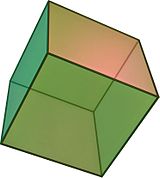



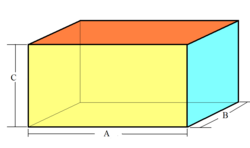







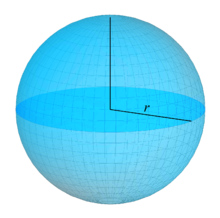
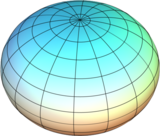

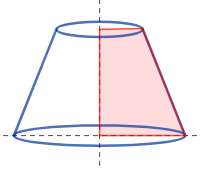

























![{\displaystyle A={\frac {n}{4}}\left[\left(a_{1}^{2}+a_{2}^{2}\right)\cot {\frac {\pi }{n}}+{\sqrt {\left(a_{1}^{2}-a_{2}^{2}\right)^{2}\sec ^{2}{\frac {\pi }{n}}+4h^{2}\left(a_{1}+a_{2}\right)^{2}}}\right]}](https://wikimedia.org/api/rest_v1/media/math/render/svg/57c9ba44195955a9024eca9605b00b44cdbe785a)
































